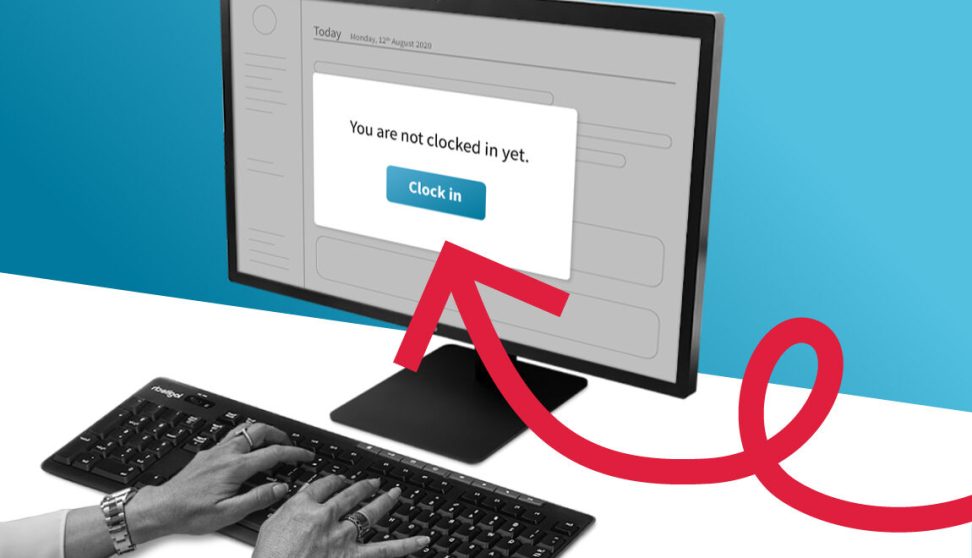Clocking in and out - How to prevent employees from forgetting to do it


When implementing any time and attendance system, one of the biggest issues is to make sure employees are consistently clocking in and out.
In most cases it’s not that they don’t want to, it’s just something that we all tend to forget from time to time, especially when we are changing work locations and using mobile time clocks to register our hours.
In this article you will find some key ideas and tactics on how to prevent employees from forgetting to clock in and out.
- Not clocking in and out intentionally or unintentionally
- What the law says about failed clock-ins
- 1. Create a policy for clocking in/out in your Employee Handbook
- 2. Set the protocol for reporting and correcting missing clock ins
- 3. Follow the clocking in/out policy through consistently
- 4. Choose a user-friendly way of clocking in with notifications
- What you should do if an employee doesn’t have an accurate timesheet
We’ve helped hundreds of companies to implement our time and
attendance system, All Hours, and gained first-hand experience from many
different sectors on how to ensure consistency in clocking in and out.
Before we start, please be aware that correct payroll calculation based on time & attendance is also about meeting legal compliance.
Not paying employees for hours they have worked (even if not registered on timesheets) can lead to very real legal consequences, so the topic must be taken seriously.
Not clocking in and out intentionally or unintentionally
More often than not people simply forget to clock in, but there can also be cases when employees try to play the system.
“Forgetting” to clock in and out can be a very convenient solution for employees who tend to be tardy or leave work early. This way they can cover up being late and even get paid for the time when they were not at work.
Playing the system is often called “time theft” and can take several forms:
- Not clocking in or out correctly to receive payment for hours not worked
- Getting a coworker to punch the timecard of someone else (also called buddy punching)
- Prolonging breaks
- Covering up late clock-in or early clock-out in any other way
In some cases employees may over-report hours to increase their payment. Most probably, you will have seen one or all of the aforementioned cases before.
What the law says about failed clock-ins
The Fair Labor Standards Act, or FLSA, is a federal law that regulates compensation for employees. Under the FLSA, the employer cannot penalize an employee who fails to clock in by reducing their wage.
The FLSA requires the employer to pay their employees for all hours worked, even if the timecard doesn’t reflect those hours.
To look at a at a practical case, if an employee forgets to clock in and still works a full day, the company must adjust the employee’s hours, and pay them accordingly.
This means that forgetful and deceitful employees are the company’s problem and you need to have certain policies in place that contain procedures for when employees forget to clock in or out.
1. Create a policy for clocking in/out in your Employee Handbook
While it is hard to immediately fix any issues that you are having with clocking in, implementing the right policies and communicating them effectively is a great start.
When drafting a policy for your Employee Handbook, make sure to include where, when, and how workers should clock in/out. Include a reminder for your employees that you expect them to clock in and out regularly, and describe the warning system when they fail to do so.
In such an Employee Handbook you should also include rules about lunch time, unpaid breaks, and overtime. You can also add the timesheet rounding practices that are being used in your company.
2. Set the protocol for reporting and correcting missing clock ins
Write very clearly in the Employee Handbook how you will respond to repeated errors made with clocking in. Include a clear outline of the progressive disciplinary action in case of repeated failure to follow procedures, such as:
- An informal talk about the issue
- Formal verbal warnings
- Written warnings
- Probation
- Suspension
- And finally, termination, if there are a certain number of violations over a set period of time.
Your disciplinary policy should reflect your authority to use these actions.
Following what you have in writing in your Employee Handbook is the only way you can prevent a lawsuit for unfair practices in case of termination of the employment contract.
3. Follow the clocking in/out policy through consistently
When it comes to time and attendance discipline, you shouldn’t play favorites or show preferential treatment in following the procedures. Whether you believe that a particular missed clock-in from an employee is truly a mistake or you suspect them of time theft, you need to follow the same line of action every time.
You must apply the policy to each and every employee, no matter their performance, job title or history. This way you will send a clear message that noncompliance will not be tolerated.
Otherwise, employees will not take time and attendance seriously. This can harm the effectiveness of the policy and can even have devastating consequences in the case of litigation.
Most of the errors are usually really just mistakes, so it isn’t advisable to go in hard from the very beginning. But you should be consistent.
When an employee forgets to clock in for the first time, you should meet with them and review the policy and procedures for clocking in, and that way you can make sure they understand them. When an employee misses another clock-in, proceed with the verbal warning.
If errors keep occurring, usually the next step is written warnings. When an employee accumulates the maximum number of written warnings for failing to clock in, you can proceed by applying more serious disciplinary actions.
When time clock policies are properly introduced and communicated, most employees will most likely not reach this point, however, you should be prepared for all eventualities.
4. Choose a user-friendly way of clocking in with notifications
When errors just keep occurring no matter the warnings, and you are quite sure your employees are not trying to cheat you, it is time to consider whether the main problem lies in your clock-in system.
Let’s be real – when you are frustrated, and your employees are frustrated, and even your HR department is frustrated, you probably need to switch to a different tool.
To avoid this from the start, make sure you do proper research before deciding which system suits your needs best.
Modern online time clock applications like All Hours are working hard to help you address the potential problem of employees forgetting to clock in and out. In the age of smartphones and mobile notifications, remembering to do so really shouldn’t be something that employees need to worry about. It's important that employees can clock in online.
This is why All Hours uses notifications to remind employees to clock in and out and also when their lunch break is coming to an end. If they still miss a clock-in, they can enter it themselves through the mobile app later where it is automatically sent to an administrator for approval.
We’ve put a lot of effort into building a smart clock-in app, which will take the frustration of the process for everyone involved.
What you should do if an employee doesn’t have an accurate timesheet
If one of the employees doesn’t have an accurate timesheet, or if they to forget to submit one, HR must make their best effort to calculate the correct payroll. They must figure out how much an employee worked in a certain week or month to make the according payments.
The best way is to figure it out together with the employee and to get a verbal or written confirmation of the worked hours. Then you can calculate the payroll, which probably won’t be 100 % accurate but the best approximation in such a situation. It’s also the best you can do to avoid any penalties.
And as mentioned, all procedures should be clearly set in place, written down in the Employee Handbook, and communicated with employees to make sure it doesn’t happen again. Reminders, notifications and having a user-friendly time and attendance system will also greatly help in avoiding such situations.
Don't forget to start All Hours Free Trial >>







